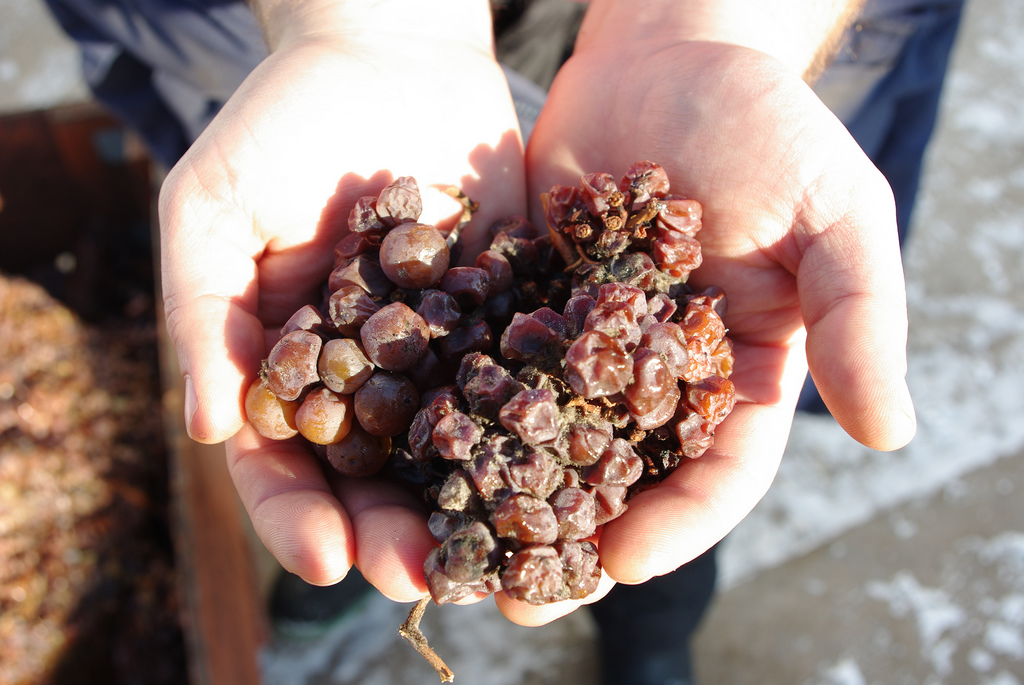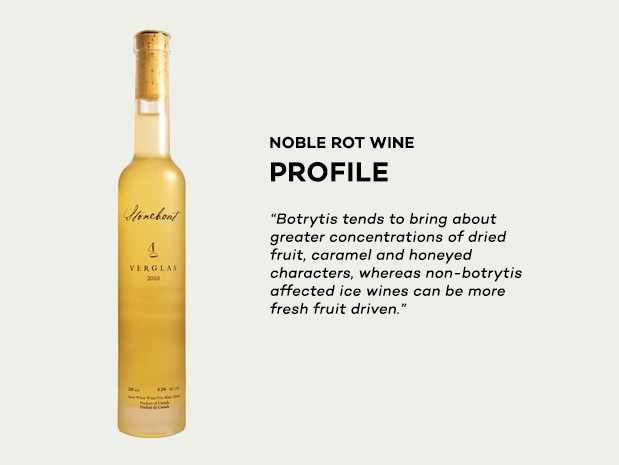What is ‘Noble Rot?’
When a vineyard full of rotting
grapes is a good thing.
‘Noble Rot’ or botrytis is a type of fungus that shrivels and decays wine grapes. Why would winemakers cross their fingers for rotting grapes? Well, there are a couple of amazing things that happen, but first, let’s find out what ‘Noble Rot’ is all about.
‘Noble Rot’ (aka Botrytis cinerea) is a type of Ascomycota within the Funghi kingdom. Other ascomycetes include the antibiotic penicillin, Stilton blue cheese and the fungus responsible for athelete’s foot. Botrytis cinerea can occur on fruits, vegetables and flowers –imagine a moldy strawberry. However with wine, it’s considered a good thing. Wines such as Sauternes from Bordeaux; Tokaji Aszu from Hungary, and Spätlese level German Riesling all are made from ‘Noble Rot’ grapes.

What Does ‘Noble Rot’ Do?
‘Noble Rot’ basically does two things to wine: it intensifies the sweetness level and adds flavor complexity.
Intensifies Sweetness ‘Noble Rot’ causes grapes to dehydrate while maintaining the sugar levels. More wine grapes are needed to make the same amount of juice and thus the juice has higher sugar content. Dessert wines made from Noble Rot grapes are more viscous and sweeter, some even have higher alcohol content.
Adds Flavor Sommeliers often use the words “honey,” “beeswax” and “ginger” to describe the flavors that botrytis adds to wine. This could be because Noble Rot wines often have higher levels of a special aroma compound called phenylacetaldehyde. This compound is also commonly found in buckwheat and milk chocolate.
Try Spätlese Riesling
It’s common fir Spätlese (aka ‘late harvest’) German Riesling to be made with botrytis grapes.

A Long History of Mold and Wine
Winemakers have struggled long and hard to battle mold in their vineyards and cellars. There is Powdery Mildew, a mold that affects vineyards. Cork Taint is caused by airborne funghi that come in contact with chlorophenol compounds. And finally Black Mold, a relatively harmless but ugly funghi that inhabits dank cellars throughout Europe.

Profile on a “Noble Rot” Wine
We contacted Tim Martiniuk (his grapes are pictured above) from Stoneboat Vineyards in British Columbia about his wine Verglas. It’s a wine that could be considered both an ice wine and a ‘Noble Rot’ dessert wine. So naturally we had to know more. Discover how a ‘Noble Rot’ wine comes to be.
Where does Noble Rot happen in your vineyards?
Noble rot tends to happen in the portions of the vineyard that are closer to the river. On cool fall mornings, mist from the Okanagan river drifts from the vineyard and condenses on the berries, which can encourage botrytis. It can occur anywhere in the vineyard depending on how wet a year is, but we manage blocks of other varietals differently to prevent the [mold] from developing.
Tell me about your dessert wine Verglas
The Verglas, our dessert wine, is both botrytis affected and an ice wine. Botrytis tends to bring about greater concentrations of dried fruit, caramel and honeyed characters, whereas non-botrytis affected ice wines can be more fresh fruit driven. We’ve found that in years when we have less botrytis in the dessert wine crop the resulting wine tends to be more fruity and tropical. Combining the ice wine technique with botrytis allows us to obtain the best traits of both wine types.
You mean your wine is made from frozen ‘Noble Rot’ grapes?!
Yes- we pick frozen botrytis-affected grapes for our dessert wine.
Our dessert wine was an accident of sorts. In 2006, the botrytis in our Oraniensteiner block was so intense that we couldn’t use the grapes for our table wines. We were going to abandon the crop, but it froze early that year and we decided to see if we could salvage it. We were blown away by the end result and since then have made Verglas every year.